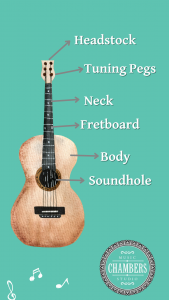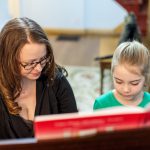Whether you’re inspired by rock legends, folk heroes, or the allure of classical guitar, anyone can learn to play the guitar.
This comprehensive guide will walk you through everything from starting out to mastering beginner techniques. Here’s everything you need to know about how to learn guitar the fast way.
The Many Benefits of Learning Guitar
Emotional Benefits
Learning the guitar offers a profound emotional outlet for self-expression. Bad day? Thrash on the guitar. Good day? Strum a sweet melody.
You can channel your feelings and experiences into your music—how therapeutic! This form of creative expression can significantly alleviate stress and improve overall well-being, providing a healthy way to process and express emotions.
Mental Benefits
Guitar requires focus and concentration, which enhances cognitive abilities and memory. It’s a multifaceted brain exercise involving coordination, listening, and multitasking skills.
Learning and mastering new songs also boosts confidence and provides a sense of achievement—who doesn’t love to feel successful?!
Social Benefits
Playing the guitar opens up opportunities for joining bands, participating in workshops, or performing for friends and family. These activities foster social bonding and cultural exploration, making the guitar a versatile instrument for connecting with others in various settings.
Choose Your Guitar
Choosing a guitar that suits your style and comfort is essential. For beginners, a nylon-string classical guitar or a steel-string acoustic guitar are great options due to their playability and affordability.
Electric guitars are also a choice if you’re more inclined towards rock or jazz. Pick a guitar that feels comfortable in your hands and is the right size for your body.
Guitars are vast and varied, with each type offering its unique sound, style, and playability.
Acoustic Guitars
- Classical Guitar: Known for its nylon strings, which produce a soft, mellow sound. Ideal for classical, flamenco, and traditional music.
- Steel-String Acoustic Guitar: Has steel strings and produces a brighter and louder sound. It’s widely used in folk, country, and rock music.
- Twelve-String Guitar: Features six pairs of strings, creating a richer and more ringing tone. They’re used in folk, rock, and pop music.
Electric Guitars
- Solid Body Electric Guitar: Known for its solid construction without a resonating soundbox. It’s versatile and used in many genres, especially rock, metal, and pop.
- Semi-Hollow and Hollow Body Electric Guitar: Offers a blend of acoustic and solid body electric guitar sounds. They’re favored in jazz, blues, and rockabilly.
Bass Guitars
- Electric Bass Guitar: Typically has four strings (but can have more) and is essential in providing the rhythmic and harmonic foundation in a band.
- Acoustic Bass Guitar: A less common variant, which is larger and can be played unplugged for a more resonant, acoustic sound.

Everything Else You Need to Start Learning Guitar
You may also want to pick up the following accessories:
A Guitar Tuner
Staying in tune is crucial for sounding good. A clip-on guitar tuner is a beginner-friendly option. These tuners are easy to use and can quickly help you get your guitar in tune. Alternatively, you can use a tuning app on your smartphone.
Guitar Picks
Picks come in various shapes and thicknesses. Beginners might find a medium-thickness pick more versatile and easier to handle. Experiment with a few different types to see what feels best for you.
A Guitar Strap
A strap is necessary if you prefer to play standing up or even to stabilize the guitar while sitting. Ensure it’s adjustable and comfortable, especially during longer practice sessions.
Spare Strings
Strings can break, so having an extra set on hand is always good. As a beginner, opt for lighter gauge strings, which are easier on the fingers.
A Metronome
Rhythm is a fundamental aspect of guitar playing. A metronome will help you keep time and improve your rhythmic accuracy. You can use a traditional metronome or a metronome app.
Learn Guitar Basics In 7 Steps
Beginning your guitar journey with a solid foundation in the basics is crucial for your development as a guitarist. Here’s how you can get started:
Step 1 – Understanding Your Guitar
Familiarize yourself with the different parts of the guitar: the body, neck, fretboard, headstock, strings, and tuning pegs. Knowing these parts will help you understand future lessons and instructions.

Step 2 – Proper Posture and Hand Positioning
Good posture is key. Sit up straight on a chair without armrests, and hold your guitar comfortably against your body. Your left hand should be on the fretboard, with fingers curved and ready to press the strings.
Your thumb should be positioned at the back of the neck. Your other hand should be over the sound hole (on an acoustic guitar) or over the pickups (on an electric guitar), ready to strum or pluck the strings.
Step 3 – How to Tune Your Guitar
Learn the standard tuning (E-A-D-G-B-e) and how to tune your guitar. This can be done using a tuner, tuning app, or by ear (comparing with another instrument or tuning reference).
Step 4 – Basic Finger Exercises
Start with simple finger exercises to build mastery. Practice placing your fingers on the fretboard and getting used to the pressure to hold the strings down. Move your fingers in various combinations to get comfortable with different positions.
Step 5 – Basic Chords and Strumming Patterns
Learn a few basic open chords, such as C, G, D, A, and E. These chords are foundational in many songs and will help you get a feel for chord transitions.
Begin with basic strumming patterns. Understand the difference between downstrokes (strumming from the top string down) and upstrokes (from the bottom string up). Start slowly, focusing on consistency and rhythm.
Step 6 – Reading Chord Diagrams and Tablature
Get acquainted with reading guitar chord diagrams and tablature (tabs). Chord diagrams show where to place your fingers on the fretboard, while tabs provide a simple way to read music for the guitar, indicating which frets to press on which guitar strings.
You can find guitar tabs for your favorite songs and learn how to play them by searching online.
Step 7 – Finding Songs to Learn
Start with simple songs that use the chords and strumming patterns you’ve learned. Choose songs you enjoy, as this will keep you motivated. These songs will help you understand basic rhythms and how to count beats. Practice playing along with a metronome to develop your sense of timing.

Building Upon the Basics
Building on the basics means going beyond recognizing chords to understanding their construction and function within scales. For guitarists, it could involve learning how different chord shapes are formed across the fretboard.
To enhance your technique, focus on refining basic techniques like strumming, basic picking, and maintaining rhythm. Additionally, incorporate simple finger exercises to improve agility.
Once you get the basics down, you can also engage in ear training exercises to improve the ability to identify notes and chords by ear.
Understanding Chord Progressions
Chord Progression Theory is a fundamental aspect of music theory that involves studying and using chord sequences in music. It’s critical to understanding how music flows and changes over time within a piece.
Musicians use this theory to compose music, improvise, and understand the structure of songs. It’s also essential for arranging music and creating harmonizations.
What are Chord Progressions?
Chord progressions are a series of chords played in a sequence. They are the building blocks of harmony in music. A progression gives the music its shape and character and is often responsible for setting the mood or emotion of a piece.
In chord progression theory, chords have functions like tonic (restful and stable, usually the I chord), subdominant (provides movement away from tonic, often the IV chord), and dominant (creates tension, leading back to the tonic, typically the V chord).
The Role of Key Signatures
Each chord progression generally takes place within a specific key. The key of a piece of music dictates the scale from which its chords are derived. For example, a song in C major will predominantly use chords made from the C major scale.
Different keys are used for creating different moods and feelings, and for the comfort of the singer’s vocal range.
Common Chord Progressions
Certain progressions are widely used across various musical genres due to their pleasing harmonic qualities. For example, the I-IV-V progression is common in blues and rock, while the ii-V-I progression is a staple in jazz music.
Chords within a progression are often referred to by Roman numerals, which represent their scale degree. In the key of C major, C is the I chord (first degree), Dm is the ii chord (second degree), and so on.
Mastering Finger Positions
Mastering finger positions is a crucial aspect of playing any stringed instrument, like the guitar or piano. It involves developing the ability to place your fingers on the instrument’s strings or keys accurately and efficiently, enabling you to play chords, melodies, and rhythms effectively.
Know the notes on the fretboard. Each fret represents a half step in the musical scale.
Fingers should be curved and relaxed, not flat or tense.
Each finger should be responsible for a specific fret or key area to minimize movement and increase speed and accuracy.
Consistent practice of scales, arpeggios, and chord shapes helps ingrain finger positions into muscle memory.
Tips for Beginner Players
Start with the Basics
Focus on learning the basic principles and techniques. This could be basic chords on a guitar, fundamental strokes in tennis, or basic grammar in a new language.
Consistent Practice
Consistency is key. Even short, daily practice sessions are more effective than long, infrequent ones. Try to practice at the same time each day to establish a routine.
Patience and Perseverance
Progress in skills often takes time. Don’t get discouraged by initial difficulties. Acknowledge and celebrate your progress, no matter how small.

Take It To the Next Level With Guitar Lessons
Are you passionate about guitar playing but feel like you’ve hit a plateau? Do you dream of strumming chords effortlessly, mastering complex solos, or composing your own songs? It’s time to take your guitar skills to the next level, and we’re here to help you do just that!
Whether you’re a beginner looking to solidify your foundation or an intermediate player aiming to explore new styles and techniques, our tailored lessons will provide the roadmap to your success.







